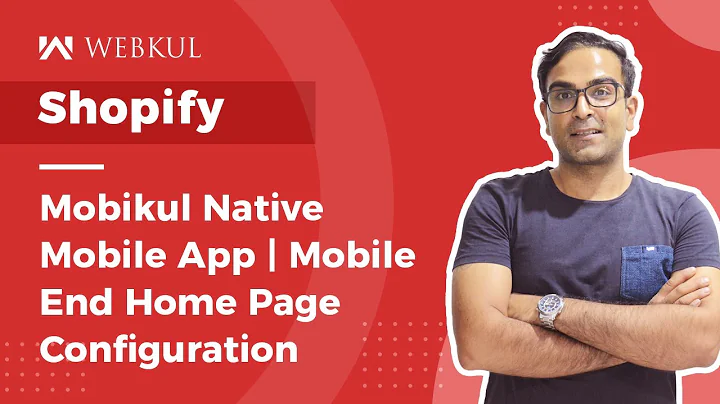Create a Profitable Shopify Dropshipping Store with One-Click Checkout
Table of Contents
- Introduction
- Getting Started with Shopify
- Choosing and Installing Apps
- Customizing Your Theme
- Setting Up Colors and Design
- Creating a Slideshow
- Adding Product Information
- Configuring the Footer
- Creating Product Pages
- Setting Up Reviews and Ratings
- Finalizing Your Website
- Conclusion
Introduction
Creating a successful Shopify dropshipping store can be a lucrative venture. With the right platform and strategies in place, it's possible to build a profitable online business. In this article, we will provide a step-by-step guide on how to create a Shopify dropshipping store with a one-click checkout. We will cover the essential steps, including setting up your store, installing necessary apps, customizing your theme, optimizing product pages, and more. So, let's dive in and get started on building your Shopify dropshipping store.
How to Create a Shopify Dropshipping Store with One-Click Checkout
Creating a successful Shopify dropshipping store can be a lucrative venture. With the right platform and strategies in place, it's possible to build a profitable online business.
1. Introduction
With the increasing popularity of dropshipping, many entrepreneurs are turning to Shopify as their go-to platform. In this guide, we will walk you through the process of creating a Shopify dropshipping store with a one-click checkout.
2. Getting Started with Shopify
Before you begin, you'll need to sign up for a Shopify account. Once you've created your account, you can start setting up your store by choosing a domain name, selecting a theme, and customizing your store settings.
Pros:
- Shopify offers a user-friendly interface, making it easy for beginners to navigate.
- The platform provides various customization options, allowing you to create a unique store design.
- Shopify has a built-in payment gateway, simplifying the checkout process for customers.
Cons:
- Shopify charges transaction fees for certain payment methods, which can eat into your profits.
- The cost of using Shopify can be higher compared to other platforms, especially if you opt for premium themes and apps.
3. Choosing and Installing Apps
To enhance the functionality of your Shopify dropshipping store, you'll need to install relevant apps. There are several apps available that can simplify the dropshipping process, such as product review integration, inventory management, and order fulfillment.
Pros:
- Apps can automate various tasks, saving you time and effort.
- Integrating apps can enhance the customer experience, resulting in higher conversions.
- Many apps offer free trials, allowing you to test their features before committing to a subscription.
Cons:
- Installing too many apps can slow down your website's loading speed.
- Some apps may come with additional costs, increasing your expenses.
4. Customizing Your Theme
Choosing the right theme for your Shopify dropshipping store is crucial. It should reflect your brand and products while providing a smooth and visually appealing user experience. Customizing your theme involves adjusting colors, layouts, fonts, and adding branding elements.
Pros:
- Customizing your theme can help you create a unique and professional-looking store.
- A well-designed theme can enhance user engagement and increase conversions.
- Shopify offers a vast selection of themes, both free and paid, catering to different industries and styles.
Cons:
- Customizing your theme may require some HTML/CSS knowledge if you want to make advanced changes.
- Changing your theme frequently can disrupt the user experience and affect your store's consistency.
5. Setting Up Colors and Design
Colors play a significant role in branding, evoking specific emotions and associations. When setting up your colors, consider your product niche and target audience. Ensure that the color scheme aligns with your brand identity and creates a visually appealing website.
Pros:
- A well-chosen color scheme can create a cohesive and professional look for your store.
- Utilizing colors effectively can influence customer perceptions and behavior.
- Shopify's customization options make it easy to update your color scheme to match current design trends.
Cons:
- Choosing the wrong color scheme can negatively impact user experience and drive customers away.
- Overusing colors or using clashing color combinations can create a visually overwhelming website.
6. Creating a Slideshow
Adding a slideshow to your homepage can grab visitors' attention and showcase your best-selling or featured products. Make sure to include high-quality images, engaging headlines, and clear call-to-actions. The slideshow should be visually appealing and provide relevant information to entice customers to explore your store further.
Pros:
- A well-designed slideshow can captivate visitors and encourage them to stay on your website.
- Using compelling visuals and persuasive headlines can promote your products effectively.
- Slideshows allow you to highlight multiple products or promotions in a compact space.
Cons:
- Slideshows with too many slides or slow transitions can negatively impact website performance.
- Poorly optimized images or large file sizes can cause slow-loading slideshows, leading to increased bounce rates.
7. Adding Product Information
When setting up your product pages, it's essential to provide accurate and enticing information. Focus on creating compelling product descriptions, high-quality images, and clear pricing details. Consider utilizing bullet points, customer reviews, and related product recommendations to enhance the overall product experience.
Pros:
- Detailed and persuasive product descriptions can increase customer trust and conversion rates.
- High-quality images showcase your products effectively and help customers make informed purchasing decisions.
- Including customer reviews and related product recommendations can improve cross-selling and upselling opportunities.
Cons:
- Writing product descriptions can be time-consuming, especially if you have a large inventory.
- Poor-quality product images or descriptions can lead to customer dissatisfaction and returns.
8. Configuring the Footer
The footer provides essential information and navigation options for your customers. Include necessary links such as contact information, privacy policy, terms of service, refund policy, and shipping details. Ensure that the footer is organized, visually pleasing, and easily accessible from any page on your website.
Pros:
- A well-designed footer can enhance the overall user experience and provide important information.
- Including links to policies and terms of service can build trust and transparency with customers.
- Customizable footer sections allow you to add additional elements such as social media icons or newsletter sign-ups.
Cons:
- Overcrowding the footer with excessive links or information can overwhelm visitors.
- Neglecting to include essential links or policies can lead to customer confusion and trust issues.
9. Creating Product Pages
Product pages are the heart of your Shopify dropshipping store. When creating product pages, focus on high-quality images, compelling titles, persuasive descriptions, and user-friendly layouts. Include clear calls-to-action, pricing information, and any additional product attributes or variants.
Pros:
- Well-designed product pages can showcase your products effectively and increase conversions.
- Utilizing high-quality images and persuasive descriptions can build trust and interest in your products.
- Including clear calls-to-action and pricing information makes it easy for customers to make a purchase.
Cons:
- Creating compelling product pages may require professional photography or graphic design services.
- Poorly optimized images or slow-loading product pages can lead to increased bounce rates and lost sales.
10. Setting Up Reviews and Ratings
Customer reviews and ratings can significantly impact the purchasing decisions of potential buyers. Integrating a review app into your Shopify dropshipping store allows customers to leave feedback and share their experiences. Encourage satisfied customers to leave reviews, as positive reviews can build trust and credibility.
Pros:
- Customer reviews and ratings provide social proof and build trust among potential buyers.
- Displaying reviews can increase conversion rates and encourage repeat purchases.
- Monitoring and responding to customer reviews allows you to address concerns and maintain positive customer relationships.
Cons:
- Negative reviews can impact your store's reputation, requiring prompt and professional management.
- Fake or spam reviews can undermine trust in your store if not properly controlled.
11. Finalizing Your Website
Before launching your Shopify dropshipping store, thoroughly test all features and functionalities to ensure they are working correctly. Perform multiple test orders, check for any broken elements, and verify that all payment and shipping methods are functioning as intended. Additionally, optimize your store for mobile devices, as many customers will access your website on smartphones or tablets.
Pros:
- Thoroughly testing your website ensures a seamless and hassle-free customer experience.
- Conducting test orders allows you to identify and address any issues before customers encounter them.
- Optimizing your store for mobile devices improves accessibility and user satisfaction.
Cons:
- Testing and optimizing your website can be time-consuming and require attention to detail.
- Failing to thoroughly test your website may result in customer frustration and lost sales opportunities.
12. Conclusion
Creating a Shopify dropshipping store with one-click checkout can be a highly profitable venture if done correctly. By following the steps outlined in this guide, you can build a successful online business and start generating revenue. Remember to continuously monitor and optimize your store based on customer feedback and market trends. With dedication and perseverance, your Shopify dropshipping store can become a thriving e-commerce business.






















